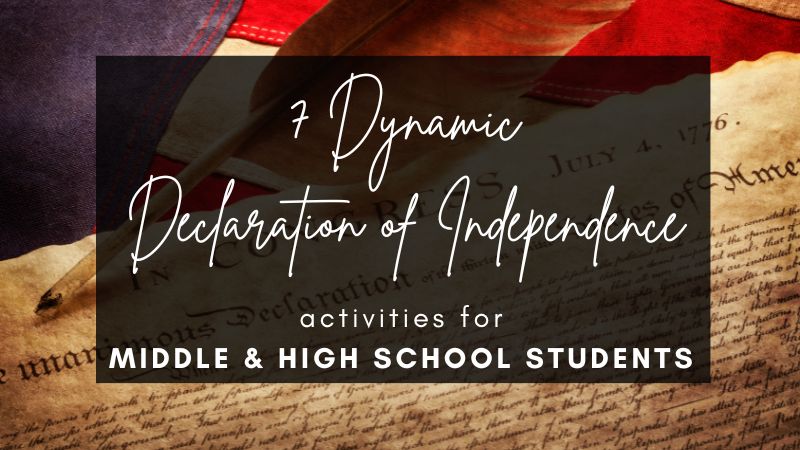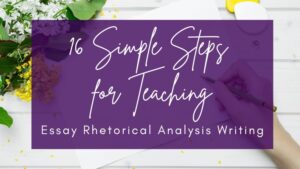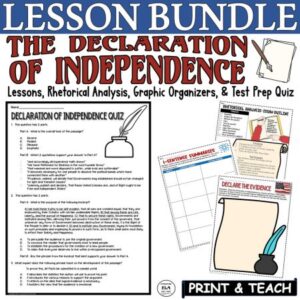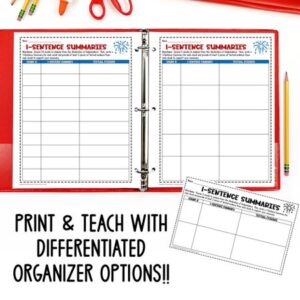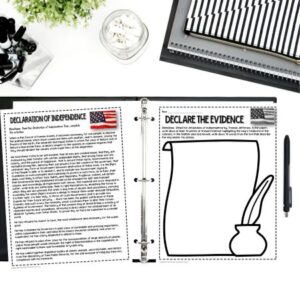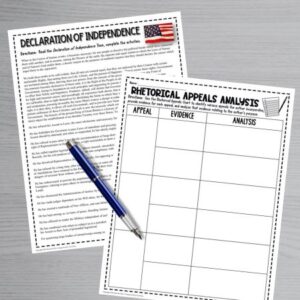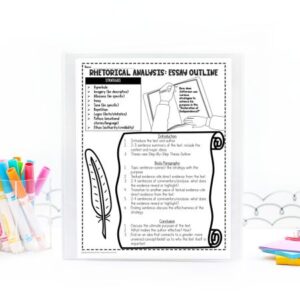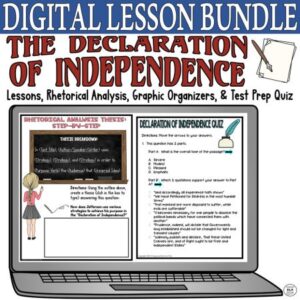The Declaration of Independence was initially authored by Thomas Jefferson amid ever-increasing tensions between England and colonial America in the mid-1770s. No one could have foreseen the lasting effects of this momentous document over 250 years later. And this is why I am absolutely passionate about taking the time to teach the Declaration of Independence every year through engaging and relevant Declaration of Independence activities!
Growing up, my family visited many American Revolutionary historical sites such as Yorktown, Williamsburg, Mount Vernon, Monticello, etc. These trips became an important and memorable part of my childhood. In 8th grade, I even got to stay in Washington D.C. for a week! Delving into history became a part of my being, and I pray our current generation of children get to experience their country’s history as an integral part of growing up.
Every age group, to some degree, can participate in the reading, comprehension, and analysis of this great American work! And if we are to keep our God-given rights, we MUST encourage our public, private, and homeschool teachers to educate our students about this text and its vital importance!
Keep reading below for 7 Declaration of Independence Activities!
Need help with Test Prep? Check out this FREE Pack of 3 Test Prep Activities to help students achieve success on standardized tests!

7 Dynamic Declaration of Independence Activities
1. Examine American Revolution Film Clips as a Pre-Reading Activity
While I love learning about the American Revolution, many of our students don’t, not necessarily because of the subject matter though. They may not have been regularly exposed to colonial America: the setting, the politics, the culture, etc.
Before reading, try examining movie and/or television clips, rather than full shows like 1776, John Adams, Drums Along the Mohawk, Hamilton, and my favorite, The Patriot. If you are teaching younger kiddos, you might want to view Liberty Kids or an episode from The Tuttle Twins.
2. Listen to a Dramatic Reading
It will be completely overwhelming if you try reading the Declaration of Independence for all of your classes, especially if you teach middle or high school students. Instead, find a dramatic reading online.
Many, many years ago, I remember sitting in my car on July 4th, and I stumbled upon an NPR reading. It was fun, fascinating, and steadfast in my memory. In fact, I was blown away by the fact that I had never even read it before.
You can always reread certain excerpts; however, reading the whole text for every class will make for a LONG day or week.
If you need help teaching about rhetoric, check out 16 Simple Steps for Teaching Essay Rhetorical Analysis Writing!
3. Annotate for a Purpose
If you have ever tried assigning annotations to your students, you will quickly discover that they are usually horrible at annotating for several reasons.
- They don’t want to read something we assign.
- They don’t know how to annotate properly.
- They don’t feel like doing anything that day.
I get it! It can be tough to motivate students to read an “ancient” text and participate in the Declaration of Independence activities like annotating the text!
To make it a bit easier and more fun, let’s give students a purpose other than to highlight, underline, or take notes while reading.
PURPOSES FOR ANNOTATING:
- Tricky Vocabulary- Choose a chunk and underline higher-level words and guess the meaning based on the context and/or roots. You could also take the time to look up the words.
- Shifting Tones- Highlight where the tones shift throughout the document. Underline the evidence supporting the shift. Explain through short notes what has changed.
- S.P.A.U.T.S.- Identify textual evidence for each concept (Speaker, Purpose, Audience, Universal Ideas, Tone, Strategies).
- Making a Case for Independence- Underline the evidence for each reason presented in the text.
- Rhetorical Appeals- Find 3-5 pieces of evidence for each appeal (Logos, Pathos, & Ethos).
- Devices- Locate various devices and label each (repetition, imagery, metaphor, simile, alliteration, etc.). Take a short note about its importance in the margins.
- Chunk Purpose- In your own words, write down the purpose of each chunk (paragraph, excerpt, sentence, etc.) and underline details to support your notes.
Make sure to model examples for your students and keep these on the board. And by all means, let them work together if you can! This text is tough!
By following the I Do, We Do, You Do method of teaching, your students will be able to use your examples and their own to guide further responses!
See the bundle below for Declaration of Independence activities and lessons!
4. Create 1-Sentence Summaries
Otherwise known as a JIST statement, 1-Sentence Summaries help students break down large texts by focusing on smaller excerpts or paragraphs. They need to underline the most important details of each chunk and summarize the chunk in their own words using a single sentence.
You can assign 1 chunk or several chunks for each pair or group for differentiation. If your students need a challenge, you can assign all of the Declaration of Independence chunks!
Click below for easy-to-teach Declaration of Independence activities with differentiated summary writing options!
5. Gather Evidence for the Case for Independence
Essentially, the Declaration of Independence argues for separation from England through a focused claim and substantial evidence throughout.
Make sure to read the entire Declaration of Independence, so students can see all of the evidence before completing the activity. In an organizer, write down at least 5 (or more) pieces of textual evidence highlighting the king’s treatment of the colonists; write down 5 words/phrases from the text that describe the king and/or his actions.
Really, the more logically-based evidence the better, especially when it comes to what Declaration of Independence activities to teach!
6. Analyze the Rhetoric
Ultimately, analyzing rhetoric’s purpose, identifying rhetorical strategies, viewing the rhetoric’s claims and counterclaims, and critically responding to the rhetorical language is our goal, or at least it should be.
Yes, not all students will understand every word or turn of phrase from the Declaration of Independence; however, we MUST get them thinking beyond what a text is merely saying. A quick quiz or reading comprehension questions might help initially, but we really need to dig more deeply and demonstrate what the critical thinking process looks like.
Let’s look at a passage and response from the Declaration of Independence activities bundle:
Directions: Use the Rhetorical Appeals Chart to identify various appeals the author incorporates, provide evidence for each appeal, and analyze that evidence relating to the author’s purpose.
| PATHOS-emotional language and imagery | Ex. “He has plundered our seas, ravaged our Coasts, burnt our towns, and destroyed the lives of our people.” | Ex. This description reveals the horrible acts of the English against the colonists with an emphasis on the all-consuming destruction the colonists have faced. By using this depiction, Jefferson seeks to elicit sympathy for the colonists’ right to declare independence in light of what they have suffered. |
After students have understood the reason, examined the rhetorical appeal used, and explained the author’s purpose in using the appeal, we can go even further in hyper-focusing on the reasons used to justify war.
This rhetorical language, while very emotional and overall passionate, is reasoned and well-thought-out. Jefferson makes claims that he can easily substantiate.
- Has the King “plundered our seas” and taken resources from various American ships? Yes!
- Has the King “ravaged our Coasts” by regulating trade to the detriment of the American economy? Yes!
- Has the King “burnt our towns?” Yes!
- Has the King “destroyed the lives of our people” whether politically, financially, or physically? Yes!
Students can fill out this chart below or you can assign groups to analyze different appeals in various Declaration of Independence activities!
7. Respond in Writing
When students write, they remember. The research is clear on this! Including Declaration of Independence activities involving writing is vital for developing comprehension and analytical skills.
So why not have students write in response through various differentiated ways in the Declaration of Independence activities?
Here are some options you might consider:
- Answer simple or more complex reading comprehension questions with complete sentences. You know which students need help and which students need more of a challenge!
- Respond to questions in paragraph form. Be sure to require evidence for every response.
- Write a rhetorical analysis short response or full essay. Students can even write an introduction with one body paragraph or a fully-developed 5 paragraph essay.
- Compose a journal entry reflecting on how the Declaration of Independence applies to oneself. Students can choose specific quotes to focus on!
- Create a Declaration of Independence of their own. They can declare separation from a hobby, person, societal issue, etc. Making it satirical might be fun as well!
Check out the bundle below for Declaration of Independence Activities involving writing!
Why should we include more Declaration of Independence activities?
If we don’t remember our past, we cannot see our way forward.
Children, teenagers, and even adults today don’t fully know the details of American history as they should. Just ask anyone on the street, and many will not even know why we celebrate July 4th. It is disturbing and unnecessary in light of the accessibility of knowledge across the country.
With a simple press of a button, practically anyone can read one of the greatest documents ever written, one that calls out tyranny and argues for rights given to us by God. We must read, reflect, and remember, or we will soon forget as a nation. We can do all this as we teach Declaration of Independence activities!
We hold these truths to be self-evident, that all men are created equal, that they are endowed by their Creator with certain unalienable Rights, that among these are Life, Liberty and the pursuit of Happiness.
Preamble to the Declaration of Independence Activities
Need help with teaching the Declaration of Independence by Thomas Jefferson? This Declaration of Independence Activities BUNDLE uses the Common Core standards and contains test prep QUESTIONS and ANSWERS (modeled after various state exams and assessments) as well as a Rhetorical Analysis Writing Pack and Citing Evidence Activities, and 1-Sentence Summaries Organizers!
Need more fun Declaration of Independence activities? Check out my store Kristin Menke-Integrated ELA Test Prep!

